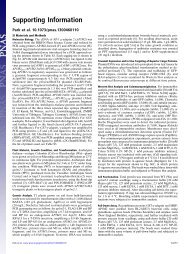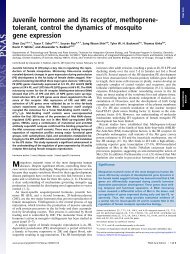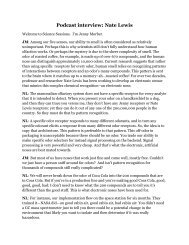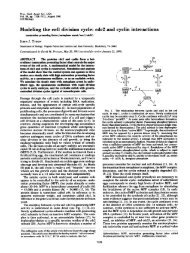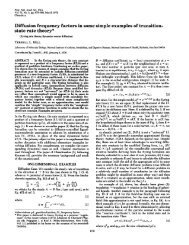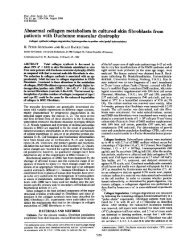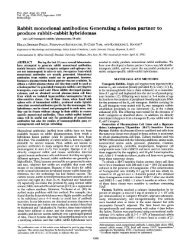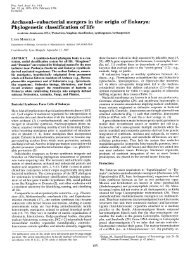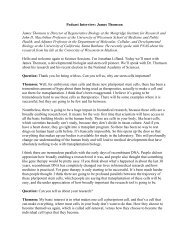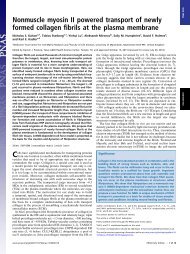Floral homeotic genes are targets of gibberellin signaling in flower ...
Floral homeotic genes are targets of gibberellin signaling in flower ...
Floral homeotic genes are targets of gibberellin signaling in flower ...
Create successful ePaper yourself
Turn your PDF publications into a flip-book with our unique Google optimized e-Paper software.
<strong>Floral</strong> <strong>homeotic</strong> <strong>genes</strong> <strong>are</strong> <strong>targets</strong> <strong>of</strong> <strong>gibberell<strong>in</strong></strong><br />
<strong>signal<strong>in</strong>g</strong> <strong>in</strong> <strong>flower</strong> development<br />
Hao Yu* † , Toshiro Ito*, Yuanxiang Zhao*, J<strong>in</strong>rong Peng ‡ , Prakash Kumar † , and Elliot M. Meyerowitz* §<br />
*Division <strong>of</strong> Biology 156-29, California Institute <strong>of</strong> Technology, Pasadena, CA 91125; † Department <strong>of</strong> Biological Sciences, Faculty <strong>of</strong> Science, National<br />
University <strong>of</strong> S<strong>in</strong>gapore, 10 Science Drive 4, S<strong>in</strong>gapore 117543; and ‡ Institute <strong>of</strong> Molecular and Cell Biology, 30 Medical Drive, National University <strong>of</strong><br />
S<strong>in</strong>gapore, S<strong>in</strong>gapore 117609<br />
Contributed by Elliot M. Meyerowitz, April 3, 2004<br />
Gibberell<strong>in</strong>s (GAs) <strong>are</strong> a class <strong>of</strong> plant hormones <strong>in</strong>volved <strong>in</strong> the<br />
regulation <strong>of</strong> <strong>flower</strong> development <strong>in</strong> Arabidopsis. The GA-deficient<br />
ga1-3 mutant shows retarded growth <strong>of</strong> all floral organs, especially<br />
abortive stamen development that results <strong>in</strong> complete male sterility.<br />
Until now, it has not been clear how GA regulates the<br />
late-stage development <strong>of</strong> floral organs after the establishment <strong>of</strong><br />
their identities with<strong>in</strong> floral meristems. Various comb<strong>in</strong>ations <strong>of</strong><br />
null mutations <strong>of</strong> DELLA prote<strong>in</strong>s can gradually rescue floral<br />
defects <strong>in</strong> ga1-3. In particular, the synergistic effect <strong>of</strong> rga-t2 and<br />
rgl2-1 can substantially restore <strong>flower</strong> development <strong>in</strong> ga1-3. We<br />
f<strong>in</strong>d that the transcript levels <strong>of</strong> floral <strong>homeotic</strong> <strong>genes</strong> APETALA3<br />
(AP3), PISTILLATA (PI), and AGAMOUS (AG) <strong>are</strong> immediately upregulated<br />
<strong>in</strong> young <strong>flower</strong>s <strong>of</strong> ga1-3 upon GA treatment. Us<strong>in</strong>g a<br />
steroid-<strong>in</strong>ducible activation <strong>of</strong> RGA, we further demonstrated that<br />
these floral <strong>homeotic</strong> <strong>genes</strong> <strong>are</strong> transcriptionally repressed by RGA<br />
activity <strong>in</strong> young <strong>flower</strong>s whereas the expression <strong>of</strong> LEAFY (LFY)<br />
and APETALA1 (AP1) is not substantially affected. In addition, we<br />
observed the partial rescue <strong>of</strong> floral defects <strong>in</strong> ga1-3 by overexpression<br />
<strong>of</strong> AG. Our results <strong>in</strong>dicate that GA promotes the expression<br />
<strong>of</strong> floral <strong>homeotic</strong> <strong>genes</strong> by antagoniz<strong>in</strong>g the effects <strong>of</strong> DELLA<br />
prote<strong>in</strong>s, thereby allow<strong>in</strong>g cont<strong>in</strong>ued <strong>flower</strong> development.<br />
Flower development starts with the specification <strong>of</strong> floral<br />
meristem identity, and <strong>of</strong> floral organ identity with<strong>in</strong> nascent<br />
floral meristems flank<strong>in</strong>g an <strong>in</strong>florescence meristem. Dur<strong>in</strong>g this<br />
process, LEAFY (LFY) stands out as a major regulator <strong>in</strong> both<br />
<strong>in</strong>tegrat<strong>in</strong>g upstream floral <strong>in</strong>ductive signals and controll<strong>in</strong>g<br />
three classes <strong>of</strong> downstream floral <strong>homeotic</strong> <strong>genes</strong>, called A, B,<br />
and C function <strong>genes</strong>, respectively. These classes <strong>of</strong> downstream<br />
<strong>genes</strong> control floral organ identity <strong>in</strong> discrete doma<strong>in</strong>s (1–3).<br />
Although it has been clear that comb<strong>in</strong>atorial activation <strong>of</strong> A, B,<br />
and C function <strong>genes</strong> governs the identity <strong>of</strong> different floral<br />
organs (3–5), little is known about how a young floral bud with<br />
established floral organ identities cont<strong>in</strong>ues to develop <strong>in</strong>to a<br />
mature <strong>flower</strong>. It is possible that floral <strong>homeotic</strong> <strong>genes</strong> play<br />
consistent roles <strong>in</strong> <strong>in</strong>itiation and further promotion <strong>of</strong> floral<br />
organ growth because the region-specific expression <strong>of</strong> these<br />
<strong>genes</strong> is present throughout the whole process <strong>of</strong> <strong>flower</strong> development<br />
(6–11). Indeed, the C function gene AGAMOUS (AG)<br />
has been suggested to function not only <strong>in</strong> the early specification<br />
<strong>of</strong> stamen and carpel identity, but also <strong>in</strong> the late pattern<strong>in</strong>g <strong>of</strong><br />
carpel structures (12). It is noteworthy that, as a major promoter<br />
<strong>of</strong> floral <strong>homeotic</strong> <strong>genes</strong>, LFY is not expressed <strong>in</strong> <strong>flower</strong>s after<br />
stage 5 (13). If floral <strong>homeotic</strong> <strong>genes</strong> <strong>are</strong> the regulators required<br />
for both floral organ identity and their cont<strong>in</strong>ued development,<br />
the promotion <strong>of</strong> floral <strong>homeotic</strong> <strong>genes</strong> at later stages <strong>of</strong> <strong>flower</strong><br />
development should be regulated by mechanisms other than<br />
LFY-dependent ones. The <strong>gibberell<strong>in</strong></strong> (GA)-deficient ga1-3 mutant<br />
develops <strong>flower</strong>s with retarded growth <strong>of</strong> all floral organs<br />
despite their normal identities (14, 15), which provides a useful<br />
experimental system to dist<strong>in</strong>guish between the different mechanisms<br />
<strong>in</strong>volved <strong>in</strong> the establishment <strong>of</strong> floral organ identity and<br />
at least some aspects <strong>of</strong> the later development <strong>of</strong> floral organs.<br />
Gibberell<strong>in</strong>s <strong>are</strong> one class <strong>of</strong> tetracyclic diterpenoid phytohormones<br />
affect<strong>in</strong>g many aspects <strong>of</strong> plant growth and develop-<br />
ment, <strong>in</strong>clud<strong>in</strong>g seed germ<strong>in</strong>ation, root growth, stem elongation,<br />
leaf expansion, floral <strong>in</strong>duction, and <strong>flower</strong> development (16,<br />
17). Recent advances have shown that GA regulates various<br />
plant developmental programs by suppress<strong>in</strong>g a group <strong>of</strong><br />
DELLA prote<strong>in</strong> nuclear repressors (18–24). There <strong>are</strong> a total <strong>of</strong><br />
five DELLA prote<strong>in</strong>s (GAI, RGA, RGL1, RGL2, and RGL3)<br />
encoded <strong>in</strong> the Arabidopsis genome. All <strong>of</strong> these prote<strong>in</strong>s conta<strong>in</strong><br />
a conserved N-term<strong>in</strong>al DELLA doma<strong>in</strong>, which is possibly<br />
<strong>in</strong>volved <strong>in</strong> the <strong>in</strong>activation <strong>of</strong> these prote<strong>in</strong>s by GA signals (18,<br />
25). GAI and RGA <strong>are</strong> negative regulators <strong>of</strong> GA responses <strong>in</strong><br />
the control <strong>of</strong> stem elongation, <strong>flower</strong><strong>in</strong>g time, and root growth.<br />
Remov<strong>in</strong>g both gene functions causes a synergistic suppression<br />
<strong>of</strong> the correspond<strong>in</strong>g defects <strong>in</strong> ga1-3 mutants (20, 21, 24).<br />
Similarly, RGL2 is a major repressor <strong>of</strong> seed germ<strong>in</strong>ation<br />
because rgl2 null mutations can significantly promote the germ<strong>in</strong>ation<br />
<strong>of</strong> ga1-3 seeds, which require GA for normal germ<strong>in</strong>ation<br />
(22). Although it has been suggested that GA overcomes<br />
the function <strong>of</strong> DELLA repressors by <strong>in</strong>duc<strong>in</strong>g degradation <strong>of</strong><br />
these prote<strong>in</strong>s by means <strong>of</strong> a ubiquit<strong>in</strong>�proteasome-dependent<br />
pathway (25–28), the mechanisms by which these prote<strong>in</strong>s control<br />
downstream developmental processes have not yet been<br />
clarified.<br />
In this study, we f<strong>in</strong>d that GA regulates <strong>flower</strong> development<br />
by oppos<strong>in</strong>g the function <strong>of</strong> several DELLA repressors and<br />
thereby partly promot<strong>in</strong>g the expression <strong>of</strong> the floral <strong>homeotic</strong><br />
<strong>genes</strong> APETALA3 (AP3), PISTILLATA (PI), and AG. Absence<br />
<strong>of</strong> RGA and RGL2 function is almost sufficient to restore<br />
normal <strong>flower</strong> development <strong>in</strong> ga1-3 (29), <strong>in</strong>dicat<strong>in</strong>g that both<br />
<strong>genes</strong> <strong>are</strong> major repressors <strong>of</strong> GA responses <strong>in</strong> this specific<br />
process. By us<strong>in</strong>g a steroid-<strong>in</strong>ducible system for the activation <strong>of</strong><br />
RGA, we present evidence show<strong>in</strong>g that AP3, PI, and AG <strong>are</strong><br />
<strong>targets</strong> <strong>of</strong> transcriptional repression by RGA. Moreover, overexpression<br />
<strong>of</strong> AG causes partial rescue <strong>of</strong> abortive stamen<br />
development <strong>in</strong> ga1-3. Our results thus suggest that cont<strong>in</strong>uous<br />
ma<strong>in</strong>tenance <strong>of</strong> floral <strong>homeotic</strong> gene expression is important for<br />
normal <strong>flower</strong> development and that DELLA prote<strong>in</strong>s, especially<br />
RGA, play critical roles <strong>in</strong> l<strong>in</strong>k<strong>in</strong>g the GA-<strong>signal<strong>in</strong>g</strong><br />
pathway with <strong>homeotic</strong> gene activity <strong>in</strong> <strong>flower</strong> development.<br />
Materials and Methods<br />
Plant Materials. All Arabidopsis mutants used <strong>in</strong> this study <strong>are</strong> <strong>in</strong><br />
the Landsberg erecta (Ler) background unless stated otherwise.<br />
They were grown at 22°C <strong>in</strong> cont<strong>in</strong>uous light. To break dormancy,<br />
all seeds with ga1-3 background were imbibed <strong>in</strong> 100 �M<br />
GA at 4°C for 7 days, and then r<strong>in</strong>sed thoroughly with water<br />
before sow<strong>in</strong>g. Mutant l<strong>in</strong>es ga1-3, rgl1-1, rgl2-1, gai-t6, rga-t2,<br />
ga1-3 rgl1-1, ga1-3 rgl2-1, ga1-3 gai-t6, ga1-3 rga-t2, and ga1-3<br />
gai-t6 rga-t2 have been described (22). The other mutant l<strong>in</strong>es <strong>in</strong><br />
this study were created by cross-poll<strong>in</strong>ation between the above<br />
Abbreviations: GA, Gibberell<strong>in</strong>; GR, glucocorticoid receptor; LFY, LEAFY; AG, AGAMOUS;<br />
PI, PISTILLATA; AP1, APETALA1; AP2, APETALA2; AP3, APETALA3.<br />
§ To whom correspondence should be addressed. E-mail: meyerow@its.caltech.edu.<br />
© 2004 by The National Academy <strong>of</strong> Sciences <strong>of</strong> the USA<br />
www.pnas.org�cgi�doi�10.1073�pnas.0402377101 PNAS � May 18, 2004 � vol. 101 � no. 20 � 7827–7832<br />
PLANT BIOLOGY
elevant mutants, and their genotypes were verified as reported<br />
(21, 22).<br />
To create ga1-3 rga-t2 35S::RGA-GR, ga1-3 rga-t2 was treated<br />
weekly with 100 �M GA and transformed with the b<strong>in</strong>ary vector<br />
harbor<strong>in</strong>g the 35S::RGA-GR cassette. Transgenic plants conta<strong>in</strong><strong>in</strong>g<br />
35S::RGA-GR were screened by Basta selection and<br />
further tested for phenotypic effects by dexamethasone treatment.<br />
We isolated one transgenic l<strong>in</strong>e, which conta<strong>in</strong>s only one<br />
transgene <strong>in</strong>sertion and shows the phenotype closely resembl<strong>in</strong>g<br />
ga1-3 after dexamethasone treatment, to cross with ga1-3 rgl2-1<br />
rga-t2 to create ga1-3 rgl2-1 rga-t2 35S::RGA-GR.<br />
To create 35S::AG-GR, Arabidopsis ecotype Landsberg erecta<br />
(Ler) was transformed with the b<strong>in</strong>ary vector harbor<strong>in</strong>g the<br />
35S::AG-GR cassette (T.I. and E.M.M., unpublished results). We<br />
selected a transgenic l<strong>in</strong>e, which conta<strong>in</strong>s only one transgene<br />
<strong>in</strong>sertion and shows the phenotype closely resembl<strong>in</strong>g 35S::AG<br />
after dexamethasone treatment, to cross with ga1-3 to generate<br />
ga1-3 35S::AG-GR.<br />
Dexamethasone treatment and sample collection were as<br />
described (30).<br />
Plasmid Constructs. We constructed a derivative pGreen0229TI<br />
vector by clon<strong>in</strong>g the cauli<strong>flower</strong> mosaic virus 35S coat prote<strong>in</strong><br />
gene (35S) promoter with tandem enhancers and transcriptional<br />
term<strong>in</strong>ator <strong>in</strong>to the KpnI and XhoI sites <strong>of</strong> pGreen0229 (31). The<br />
hormone-b<strong>in</strong>d<strong>in</strong>g doma<strong>in</strong> <strong>of</strong> the rat glucocorticoid receptor<br />
(GR) was amplified from pRI-�GR (32) by the primers GR1<br />
(5�-TCCCCCGGGGGATCCTGAAGCTCGAA-3�) and GR2<br />
(5�-GCTCTAGAGCTCAGTCATTTTTGATGA-3�). The amplified<br />
GR fragment was cut with BamHI and XbaI and cloned<br />
<strong>in</strong>to the correspond<strong>in</strong>g sites <strong>of</strong> the pGreen0229TI to generate<br />
pGreen0229TI:GR. The entire RGA cDNA was amplified by<br />
RT-PCR with the primers RGA-G1 (5�-AACTGCAGAATC-<br />
GAAACTCATAGCTGAA-3�) and RGA-G2 (5�-AAGGATC-<br />
CCCGTGCGCCGCCGTCGAGAGTTTC-3�). The result<strong>in</strong>g<br />
fragment was digested by PstI and BamHI and subsequently<br />
cloned <strong>in</strong>to the correspond<strong>in</strong>g sites <strong>of</strong> pGreen0229TI:GR to<br />
create a 35S::RGA-GR cassette.<br />
Analysis <strong>of</strong> Gene Expression. To <strong>in</strong>vestigate gene expression <strong>in</strong><br />
young <strong>flower</strong>s, we selected <strong>in</strong>florescence apices conta<strong>in</strong><strong>in</strong>g floral<br />
buds younger than stage 10. Total RNA was extracted by RNeasy<br />
Table 1. Classification <strong>of</strong> mutants <strong>in</strong> terms <strong>of</strong> their <strong>flower</strong> phenotype<br />
Plant M<strong>in</strong>i Kit (Qiagen, Valencia, CA) and reverse-transcribed<br />
by us<strong>in</strong>g the ThermoScript RT-PCR system (Invitrogen). Under<br />
our RT-PCR conditions, we performed 22–25 cycles <strong>of</strong> amplification<br />
to make sure that quantification for all <strong>genes</strong> exam<strong>in</strong>ed<br />
was with<strong>in</strong> a l<strong>in</strong>ear range. The amplified PCR products were<br />
detected as described (33). RT-PCR was repeated three times by<br />
us<strong>in</strong>g samples collected separately.<br />
Primers designed for RT-PCR were as follows: AP1-P1 (5�-<br />
GCACCTGAGTCCGACGTC-3�) and AP1-P2 (5�-GCGGC-<br />
GAAGCAGCCAAGG-3�) for APETALA1 (AP1); AP2-P1 (5�-<br />
TAGCCACCGGATCGTCCGCGGGTAAA-3�) and AP2-P2<br />
(5�-GTTGTTGTTGGTTCATCCTGAGCCGCAT-3�) for<br />
APETALA2 (AP2); AP3-P1 (5�-AGCTGCGTCGTCTTGAG-<br />
GAT-3�) and AP3-P2 (5�-GGTTTTAGCAACACCATGCCT-<br />
3�) for AP3; PI-P1 (5�-CTTACAACTGGAGCTCAGGCA-3�)<br />
and PI-P2 (5�-GCTCGAGATTAAGACACACAG-3�) for PI;<br />
AG-P1 (5�-GCTCAGGAACTTGGAAGGCAG-3�) and<br />
AG-P2 (5�-TCACTCCAGGCCATTTCCTTC-3�) for AG;<br />
LFY-P1 (5�-TGAAGGACGAGGAGCTT-3�) and LFY-P2 (5�-<br />
TTGCCACGTGCCACTTC-3�) for LFY; and TUB2-P1 (5�-<br />
ATCCGTGAAGAGTACCCAGAT-3�) and TUB2-P2 (5�-<br />
TCACCTTCTTCATCCGCAGTT-3�) for �-tubul<strong>in</strong> (TUB2).<br />
Some other primers were accord<strong>in</strong>g to the follow<strong>in</strong>g references:<br />
WUSCHEL (WUS) (34), SUPERMAN (SUP) (35), and SEPA-<br />
LLATA 3 (SEP3) (36).<br />
In Situ Hybridization. Nonradioactive <strong>in</strong> situ hybridization was<br />
performed accord<strong>in</strong>g to a published protocol (37). Synthesis <strong>of</strong><br />
antisense probes has been described (38). Sections <strong>of</strong> both WT<br />
and ga1-3 plants were placed on the same slide, which was<br />
hybridized and detected under the same conditions. The comparable<br />
panels for different probes <strong>in</strong> <strong>in</strong> situ figures were<br />
recorded from the same slide.<br />
Results and Discussion<br />
DELLA prote<strong>in</strong>s <strong>in</strong> Arabidopsis <strong>in</strong>clude GAI, RGA, RGL1,<br />
RGL2, and RGL3, which conta<strong>in</strong> a conserved DELLA doma<strong>in</strong><br />
at their N term<strong>in</strong>i (18, 25). The stability <strong>of</strong> these prote<strong>in</strong>s is<br />
thought to be reduced <strong>in</strong> the presence <strong>of</strong> GA (25–28). It has been<br />
suggested that DELLA prote<strong>in</strong>s play repressive roles <strong>in</strong> various<br />
aspects <strong>of</strong> plant growth and development (18–24). Flowers <strong>in</strong><br />
GA-deficient mutants ga1-3 possess undeveloped floral organs<br />
Degree <strong>of</strong><br />
rescue <strong>of</strong> gal-3 Genotype* Flower phenotype<br />
0 gal-3 † Retarded growth <strong>of</strong> petals, stamens and pistils; male sterility with lack <strong>of</strong> mature pollen<br />
1 gal-3 rgl1–1 † Partial rescue <strong>of</strong> gal-3 with elongated pistils<br />
gal-3 rgl2–1<br />
gal-3 gai-t6<br />
2 gal-3 rga-t2 † Partial rescue <strong>of</strong> gal-3 with elongated petals, filaments, and pistils<br />
gal-3 rgl1–1 rgl2–1<br />
gal-3 rgl1–1 gai-t6<br />
gal-3 rgl2–1 gai-t6<br />
gal-3 rgl1–1 rgl2–1 gai-t6<br />
3 ga1–3 rgl1–1 rga-t2 † Partial rescue <strong>of</strong> gal-3 with more elongated petals, filaments, and pistils<br />
gal-3 gai-t6 rga-t2<br />
ga1–3 rgl1–1 gai-t6 rga-t2<br />
4 ‡ gal-3 rgl2–1 rga-t2 † Significant rescue <strong>of</strong> gal-3 with normal petals, pistils, and much developed stamens;<br />
gal-3 rgl2–1 gai-t6 rga-t2 partial <strong>in</strong>fertility <strong>of</strong> early aris<strong>in</strong>g <strong>flower</strong>s<br />
5 gal-3 rgl1–1 rgl2–1 rga-t2 † Almost total rescue <strong>of</strong> gal-3 with normal petals, stamens and pistils; normal fertility<br />
gal-3 rgl1–1 rgl2–1 gai-t6 rga-t2<br />
*All <strong>of</strong> the plants <strong>are</strong> <strong>of</strong> the same Landsberg erecta background.<br />
† Representative mutants display<strong>in</strong>g different degrees <strong>of</strong> rescue <strong>of</strong> gal-3 <strong>are</strong> shown <strong>in</strong> Fig. 6.<br />
‡ Mutants <strong>in</strong> this degree generate two k<strong>in</strong>ds <strong>of</strong> <strong>flower</strong>s: <strong>flower</strong>s aris<strong>in</strong>g at apical positions <strong>in</strong> a ma<strong>in</strong> <strong>in</strong>florescence <strong>are</strong> fertile with significant rescue <strong>of</strong> gal-3 whereas<br />
<strong>flower</strong>s aris<strong>in</strong>g at basal positions <strong>are</strong> still sterile with the degree 3 phenotype.<br />
7828 � www.pnas.org�cgi�doi�10.1073�pnas.0402377101 Yu et al.
<strong>in</strong> all four whorls. In particular, stamen development, <strong>in</strong>clud<strong>in</strong>g<br />
filament elongation and pollen maturation, is abortive. Recently<br />
reported work (29) and our observations (Fig. 6, which is<br />
published as support<strong>in</strong>g <strong>in</strong>formation on the PNAS web site) show<br />
that various comb<strong>in</strong>ations <strong>of</strong> null mutations <strong>of</strong> DELLA prote<strong>in</strong>s<br />
gai-t6, rga-t2, rgl1-1, and rgl2-1 (22) can rescue floral phenotypes<br />
<strong>of</strong> ga1-3 to different degrees (Table 1). These results suggest that<br />
RGA and RGL2 play major functions <strong>in</strong> repress<strong>in</strong>g the cont<strong>in</strong>ued<br />
growth <strong>of</strong> floral organs, and that the sequence <strong>of</strong> the<br />
importance <strong>of</strong> DELLA prote<strong>in</strong>s <strong>in</strong>volved <strong>in</strong> <strong>flower</strong> development<br />
is RGA, RGL2, RGL1, and GAI.<br />
GA Promotes Flower Development Partly by Up-Regulat<strong>in</strong>g <strong>Floral</strong><br />
Homeotic Genes. To identify the downstream <strong>genes</strong> regulated by<br />
GA <strong>signal<strong>in</strong>g</strong>, we exam<strong>in</strong>ed the expression <strong>of</strong> a set <strong>of</strong> <strong>genes</strong><br />
<strong>in</strong>volved <strong>in</strong> floral pattern<strong>in</strong>g (12) upon GA treatment, which<br />
<strong>in</strong>cluded the floral meristem identity gene LFY, floral <strong>homeotic</strong><br />
<strong>genes</strong> AP1, AP2, AP3, PI, and AG, and floral organ identity and<br />
growth regulators WUS, SUP, and SEP3. Our results showed that<br />
the expression <strong>of</strong> B and C function <strong>genes</strong> AP3, PI, and AG was<br />
up-regulated <strong>in</strong> <strong>in</strong>florescence apices <strong>of</strong> ga1-3, �2 h after GA<br />
treatment (Fig. 1A) whereas expression <strong>of</strong> the other <strong>genes</strong> was<br />
not substantially changed under the conditions tested (data not<br />
shown). Although the selected <strong>in</strong>florescence apices for RT-PCR<br />
conta<strong>in</strong>ed floral buds from stages 1 to 10, RNA <strong>of</strong> old floral buds<br />
after stage 5 would be expected to constitute the greatest part <strong>of</strong><br />
the RNA isolated from the batch <strong>of</strong> floral buds (T.I. and E.M.M.,<br />
unpublished data). Thus, up-regulation <strong>of</strong> these floral <strong>homeotic</strong><br />
<strong>genes</strong> after GA treatment mostly reflected a change <strong>in</strong> their<br />
transcript levels <strong>in</strong> older floral buds after stage 5, after the time<br />
when the floral meristems had already established floral organ<br />
identity (39). Because GA treatment is sufficient to restore the<br />
normal growth <strong>of</strong> floral organs <strong>in</strong> ga1-3 <strong>flower</strong>s, we suggest that<br />
the promotion <strong>of</strong> floral <strong>homeotic</strong> gene expression by GA <strong>signal<strong>in</strong>g</strong><br />
may be important for the cont<strong>in</strong>ued development <strong>of</strong> floral<br />
buds to late-stage <strong>flower</strong>s, which have already established floral<br />
organ identity.<br />
To further <strong>in</strong>vestigate the potential <strong>in</strong>volvement <strong>of</strong> GA signals<br />
<strong>in</strong> the promotion <strong>of</strong> floral <strong>homeotic</strong> gene expression, we performed<br />
<strong>in</strong> situ hybridization with relevant probes, to ga1-3 and<br />
WT <strong>in</strong>florescences. The B function gene AP3 and C function<br />
gene AG were expressed at lower levels <strong>in</strong> ga1-3 than <strong>in</strong> WT<br />
plants (Figs. 2 and 3) although their expression doma<strong>in</strong>s were not<br />
changed. Such reduction <strong>of</strong> expression levels was observed<br />
through the whole process <strong>of</strong> <strong>flower</strong> development <strong>in</strong> ga1-3 but<br />
was particularly evident by stage 8 (Figs. 2 B and E and 3 B and<br />
F). On the contrary, the expression <strong>of</strong> LFY, AP2 (data not<br />
shown), and AP1 (Fig. 7, which is published as support<strong>in</strong>g<br />
<strong>in</strong>formation on the PNAS web site) was not noticeably changed<br />
<strong>in</strong> ga1-3, which is consistent with the RT-PCR result (Fig. 1A).<br />
As comp<strong>are</strong>d with their expression <strong>in</strong> ga1-3, expression <strong>of</strong> AP3<br />
and AG was also higher <strong>in</strong> ga1-3 rgl2-1 rga-t2 (data not shown),<br />
which showed significant rescue <strong>of</strong> floral defects <strong>of</strong> ga1-3,<br />
<strong>in</strong>dicat<strong>in</strong>g that GA may up-regulate the expression <strong>of</strong> target<br />
<strong>genes</strong> <strong>in</strong> <strong>flower</strong> development by overcom<strong>in</strong>g the effects <strong>of</strong><br />
DELLA prote<strong>in</strong>s, especially RGA and RGL2.<br />
Our data showed that GA can specifically and cont<strong>in</strong>uously<br />
promote the expression <strong>of</strong> B and C function <strong>genes</strong> dur<strong>in</strong>g <strong>flower</strong><br />
development, but not the LFY, AP1, and AP2 <strong>genes</strong>. The<br />
significance <strong>of</strong> this f<strong>in</strong>d<strong>in</strong>g lies <strong>in</strong> two aspects. First, comp<strong>are</strong>d<br />
with the promotion <strong>of</strong> LFY expression by GA <strong>in</strong> the control <strong>of</strong><br />
<strong>flower</strong><strong>in</strong>g time (40), LFY expression <strong>in</strong> emerg<strong>in</strong>g floral meristems<br />
is <strong>in</strong>dependent <strong>of</strong> GA <strong>signal<strong>in</strong>g</strong>. Flower phenotypes <strong>in</strong> ga1-3<br />
suggest that, without GA, the normal expression <strong>of</strong> LFY <strong>in</strong> young<br />
floral meristems is sufficient to promote the transcript levels <strong>of</strong><br />
floral <strong>homeotic</strong> <strong>genes</strong> to establish normal floral organ identity,<br />
but not enough to secure the cont<strong>in</strong>ued development <strong>of</strong> floral<br />
organs. Although we cannot exclude the possibility that GA<br />
Fig. 1. Expression <strong>of</strong> floral <strong>homeotic</strong> <strong>genes</strong>. (A) Expression <strong>of</strong> AP1, AP3, PI,<br />
and AG <strong>in</strong> <strong>in</strong>florescence apices <strong>of</strong> ga1-3 mutants mock-treated with 0.1%<br />
ethanol (M), or treated with 100 �M GA (GA). Expression analyses were done<br />
after 2h<strong>of</strong>treatment. (B) Time-course expression <strong>of</strong> AP1, AP3, PI, and AG <strong>in</strong><br />
<strong>in</strong>florescence apices <strong>of</strong> ga1-3 rgl2-1 rga-t2 35S::RGA-GR plants mock-treated<br />
with 0.03% ethanol and 0.015% Silwet L-77 (M) or treated with 10 �M<br />
dexamethasone and 0.015% Silwet L-77 (D). The �-tubul<strong>in</strong> gene (TUB2) was<br />
amplified as a quantitative control. The numbers below each lane <strong>in</strong>dicate the<br />
relative expression <strong>of</strong> each gene studied, calculated by first normaliz<strong>in</strong>g each<br />
expression signal aga<strong>in</strong>st the signal for TUB2 and then aga<strong>in</strong>st the value <strong>of</strong> a<br />
correspond<strong>in</strong>g mock-treated sample, which is always set as 1.0.<br />
<strong>signal<strong>in</strong>g</strong> may coord<strong>in</strong>ate with LFY <strong>in</strong> early development <strong>of</strong><br />
floral meristems, our results suggest that GA can promote<br />
expression <strong>of</strong> floral <strong>homeotic</strong> <strong>genes</strong> <strong>in</strong>dependently <strong>of</strong> LFY<br />
activity <strong>in</strong> late-stage <strong>flower</strong>s, where LFY expression is absent.<br />
Second, it has been reported that GA signals can greatly promote<br />
petal development <strong>in</strong> ap1-1 and ap2-1 (41), <strong>in</strong>dicat<strong>in</strong>g the<br />
possible presence <strong>of</strong> an A function-<strong>in</strong>dependent pathway <strong>in</strong><br />
floral organo<strong>genes</strong>is that can be <strong>in</strong>duced by GA signal transduction.<br />
This f<strong>in</strong>d<strong>in</strong>g may be expla<strong>in</strong>ed by the observation that<br />
GA can up-regulate B and C function <strong>genes</strong>, but not A function<br />
<strong>genes</strong>.<br />
Inducible Activation <strong>of</strong> RGA. Among the identified DELLA prote<strong>in</strong>s,<br />
RGA plays a more prom<strong>in</strong>ent role than GAI, RGL1, and<br />
RGL2 <strong>in</strong> mediat<strong>in</strong>g GA <strong>signal<strong>in</strong>g</strong> dur<strong>in</strong>g <strong>flower</strong> development<br />
(29). RGA conta<strong>in</strong>s a putative nuclear localization signal, and an<br />
RGA fusion with green fluorescent prote<strong>in</strong> is localized <strong>in</strong> the<br />
nucleus <strong>of</strong> onion epidermal cells, <strong>in</strong>dicat<strong>in</strong>g that RGA functions<br />
Yu et al. PNAS � May 18, 2004 � vol. 101 � no. 20 � 7829<br />
PLANT BIOLOGY
Fig. 2. In situ localization <strong>of</strong> AP3 expression <strong>in</strong> WT plants (A–C) and ga1-3 mutants (D–F). (A and D) An<strong>in</strong>florescence apex with stage-2 and stage-4 <strong>flower</strong>s.<br />
(B and E) A stage-8 <strong>flower</strong>. (C and F) A stage-10 <strong>flower</strong>. (Bars � 100 �m.)<br />
<strong>in</strong> the nucleus, perhaps as a transcriptional regulator (42). To<br />
further elucidate the mechanistic l<strong>in</strong>ks between GA <strong>signal<strong>in</strong>g</strong><br />
and the activity <strong>of</strong> downstream <strong>genes</strong> <strong>in</strong> <strong>flower</strong> development, we<br />
created a steroid-<strong>in</strong>ducible version <strong>of</strong> RGA <strong>in</strong> transgenic plants<br />
conta<strong>in</strong><strong>in</strong>g the RGA prote<strong>in</strong> fused to the hormone-b<strong>in</strong>d<strong>in</strong>g<br />
doma<strong>in</strong> <strong>of</strong> a rat GR under the control <strong>of</strong> a 35S promoter.<br />
Posttranslational activation <strong>of</strong> RGA can be achieved <strong>in</strong> plants<br />
transgenic for this construct by dexamethasone treatment, which<br />
releases the fusion prote<strong>in</strong> bound <strong>in</strong> the cytoplasm by means <strong>of</strong><br />
the rat prote<strong>in</strong> doma<strong>in</strong> to the nucleus (43).<br />
The loss-<strong>of</strong>-function rga mutation can partially rescue a wide<br />
range <strong>of</strong> phenotypic defects <strong>in</strong> ga1-3 plants, such as stem<br />
elongation, <strong>flower</strong><strong>in</strong>g time, and <strong>flower</strong> development (ref. 42 and<br />
Fig. 6C). To closely exam<strong>in</strong>e the effects <strong>of</strong> RGA activity, we<br />
transformed ga1-3 rga-t2 double mutants with 35S::RGA-GR.<br />
The rationale is that, if the RGA-GR prote<strong>in</strong> is biologically<br />
functional, activation <strong>of</strong> RGA by dexamethasone should revert<br />
the rescued phenotypes <strong>of</strong> ga1-3 rga-t2 to those <strong>of</strong> ga1-3. We<br />
subsequently isolated one ga1-3 rga-t2 35S::RGA-GR transgenic<br />
l<strong>in</strong>e, which showed phenotypic reversion from ga1-3 rga-t2 to<br />
ga1-3 after weekly treatment with dexamethasone (Fig. 4 A and<br />
B). This result <strong>in</strong>dicates that the RGA-GR fusion prote<strong>in</strong> has<br />
similar biological functions as WT RGA and allows control <strong>of</strong><br />
RGA activity <strong>in</strong> a glucocorticoid-dependent manner.<br />
Published work (29) and our genetic analysis <strong>in</strong>dicate that<br />
RGA is a key regulator <strong>of</strong> GA <strong>signal<strong>in</strong>g</strong> <strong>in</strong>volved <strong>in</strong> the control<br />
<strong>of</strong> cont<strong>in</strong>ued development <strong>of</strong> floral organs, as reflected <strong>in</strong> the<br />
major phenotypic difference between ga1-3 rgl2-1 rga-t2 and<br />
ga1-3 rgl2-1. The former genotype showed significant rescue <strong>of</strong><br />
floral defects as comp<strong>are</strong>d with the latter (Table 1). As RGL2<br />
is the second most important DELLA prote<strong>in</strong> after RGA <strong>in</strong> the<br />
control <strong>of</strong> <strong>flower</strong> development; lack <strong>of</strong> RGL2 activity <strong>in</strong> ga1-3<br />
would potentially remove a majority <strong>of</strong> the redundant repressive<br />
effects with RGA. Thus, <strong>in</strong> the ga1-3 rgl2-1 rga-t2 background,<br />
the steroid-<strong>in</strong>ducible activation <strong>of</strong> RGA could reveal major<br />
<strong>genes</strong> respond<strong>in</strong>g to RGA activity. We crossed ga1-3 rga-t2<br />
Fig. 3. In situ localization <strong>of</strong> AG expression <strong>in</strong> WT plants (A–D) and ga1-3 mutants (E–H). (A and E) An<strong>in</strong>florescence apex with a stage-4 <strong>flower</strong>. (B and F) A<br />
stage-6 <strong>flower</strong>. (C and G) A stage-9 <strong>flower</strong>. (D and H) A stage-12 <strong>flower</strong>. (Bars � 100 �m.)<br />
7830 � www.pnas.org�cgi�doi�10.1073�pnas.0402377101 Yu et al.
Fig. 4. A biologically active RGA-GR fusion. (A and B) Phenotypes <strong>of</strong> ga1-3<br />
rga-t2 35S::RGA-GR. Mock-treated plants (A) had the same phenotypes as<br />
ga1-3 rga-t2 whereas plants treated with 10 �M dexamethasone (B) developed<br />
as ga1-3.(C–F) Phenotypes <strong>of</strong> ga1-3 rgl2-1 rga-t2 35S::RGA-GR.Inflorescences<br />
(C) and <strong>flower</strong>s (D) <strong>of</strong> mock-treated plants had the same phenotypes as<br />
ga1-3 rgl2-1 rga-t2 whereas <strong>in</strong>florescences (E) and <strong>flower</strong>s (F) <strong>of</strong> dexamethasone-treated<br />
plants mimicked the phenotypes <strong>of</strong> ga1-3 rgl2-1. All plants were<br />
treated cont<strong>in</strong>uously once a week.<br />
35S::RGA-GR with ga1-3 rgl2-1 rga-t2 to generate ga1-3 rgl2-1<br />
rga-t2 35S::RGA-GR. As expected, mock-treated ga1-3 rgl2-1<br />
rga-t2 35S::RGA-GR (Fig. 4 C and D) showed the <strong>flower</strong><br />
phenotypes <strong>of</strong> ga1-3 rgl2-1 rga-t2 plants (Fig. 6E) whereas<br />
dexamethasone-treated plants (Fig. 4 E and F) displayed the<br />
phenotypes <strong>of</strong> ga1-3 rgl2-1 (Table 1).<br />
<strong>Floral</strong> Homeotic Genes Function Downstream <strong>of</strong> GA Signal<strong>in</strong>g. Us<strong>in</strong>g<br />
the established steroid-<strong>in</strong>ducible activation <strong>of</strong> RGA, we further<br />
studied whether the expression <strong>of</strong> floral <strong>homeotic</strong> <strong>genes</strong> is<br />
repressed by RGA activity. Dexamethasone treatment <strong>of</strong> <strong>in</strong>florescence<br />
apices <strong>of</strong> ga1-3 rgl2-1 rga-t2 35S::RGA-GR for �6 h<br />
caused very little change <strong>in</strong> AP3, PI, and AG RNA levels, but 8 h<br />
<strong>of</strong> treatment resulted <strong>in</strong> a 2-fold reduction <strong>of</strong> transcript levels <strong>of</strong><br />
these three <strong>genes</strong> (Fig. 1B), which was consistent with the<br />
up-regulation <strong>of</strong> the expression <strong>of</strong> these floral <strong>homeotic</strong> <strong>genes</strong> by<br />
GA treatment. Thus, B and C function <strong>genes</strong> <strong>are</strong> transcriptionally<br />
repressed by RGA, which is the major mediator <strong>of</strong> GA<br />
<strong>signal<strong>in</strong>g</strong> <strong>in</strong>volved <strong>in</strong> <strong>flower</strong> development.<br />
However, our results demonstrated that the expression <strong>of</strong> AP3,<br />
PI, and AG did not respond to RGA activity with<strong>in</strong> 4h<strong>of</strong><br />
treatment by dexamethasone (Fig. 1B). Furthermore, a comb<strong>in</strong>ed<br />
treatment <strong>of</strong> dexamethasone and cycloheximide, an <strong>in</strong>hibitor<br />
<strong>of</strong> translation, for 6 h did not reveal any alteration <strong>of</strong><br />
Fig. 5. Partial rescue <strong>of</strong> <strong>flower</strong> phenotype <strong>in</strong> ga1-3 by a biologically active<br />
AG-GR fusion. (A, C, and E) Mock-treated ga1-3 35S::AG-GR plants. (B, D, and<br />
F) Dexamethasone-treated ga1-3 35S::AG-GR plants. Plants were treated<br />
twice with<strong>in</strong> a 1-day <strong>in</strong>terval. Seven days after the first treatment, mocktreated<br />
plants had similar <strong>in</strong>florescences (A) toga1-3 whereas the <strong>in</strong>florescences<br />
<strong>of</strong> dexamethasone-treated plants (B) developed <strong>flower</strong>s with elongated<br />
stamens and pistils. After one month, the most advanced <strong>flower</strong>s <strong>of</strong><br />
mock-treated plants (C) conta<strong>in</strong>ed wither<strong>in</strong>g stamens, and later they were<br />
completely sterile (E). The most advanced <strong>flower</strong>s <strong>of</strong> dexamethasone-treated<br />
plants (D) conta<strong>in</strong>ed develop<strong>in</strong>g stamens, and later they were partially fertile<br />
(F). Dexamethasone treatment itself had no effects on the development <strong>of</strong><br />
ga1-3 mutants.<br />
expression <strong>of</strong> these <strong>genes</strong> (data not shown). These results imply<br />
that RGA may control the expression <strong>of</strong> these floral <strong>homeotic</strong><br />
<strong>genes</strong> <strong>in</strong> an <strong>in</strong>direct way. Also, whereas RGA may specifically<br />
regulate the B and C function <strong>genes</strong>, it does not seem to regulate<br />
AP1 and LFY because their expression did not respond either to<br />
GA treatment or to RGA activity (Fig. 1 and data not shown).<br />
To further confirm that floral <strong>homeotic</strong> <strong>genes</strong> act downstream<br />
<strong>of</strong> GA <strong>signal<strong>in</strong>g</strong> <strong>in</strong> later stages <strong>of</strong> <strong>flower</strong> development, we<br />
generated ga1-335::AG-GR, where a biologically active AG-GR<br />
fusion prote<strong>in</strong> can be <strong>in</strong>duced by dexamethasone (T.I. and<br />
E.M.M., unpublished results). If down-regulation <strong>of</strong> AG expression<br />
is partially responsible for ga1-3 floral phenotypes, provision<br />
<strong>of</strong> additional AG activity by dexamethasone should at least<br />
restore some phenotypic defects. This suggestion was confirmed<br />
by the follow<strong>in</strong>g observations. Dexamethasone treatment <strong>of</strong><br />
ga1-3 35::AG-GR provided functional AG activity, caus<strong>in</strong>g the<br />
phenotypic rescue <strong>of</strong> ga1-3 <strong>flower</strong>s with elongated stamens and<br />
pistils (Fig. 5B). At a later stage, stamen development was at<br />
least partially rescued (Fig. 5D), which eventually resulted <strong>in</strong><br />
partial fertility (Fig. 5F). However, mock-treated plants still<br />
Yu et al. PNAS � May 18, 2004 � vol. 101 � no. 20 � 7831<br />
PLANT BIOLOGY
developed as ga1-3, with retarded growth <strong>of</strong> all floral organs and<br />
<strong>in</strong>fertility (Fig. 5 A, C, and E). These observations suggest that<br />
the promotion <strong>of</strong> AG is necessary for cont<strong>in</strong>ued development <strong>of</strong><br />
reproductive organs, and that AG is a target <strong>of</strong> GA <strong>signal<strong>in</strong>g</strong> <strong>in</strong><br />
<strong>flower</strong> development.<br />
Taken together, the work presented here suggests that GA<br />
promotes normal development <strong>of</strong> floral organs partly by<br />
up-regulat<strong>in</strong>g the expression <strong>of</strong> floral <strong>homeotic</strong> <strong>genes</strong> AP3, PI,<br />
and AG. GA achieves this effect by suppress<strong>in</strong>g the function <strong>of</strong><br />
two DELLA prote<strong>in</strong>s, RGA and RGL2. It has been shown<br />
recently that GA regulates cell elongation <strong>in</strong> filament development<br />
and cellular differentiation <strong>in</strong> anthers lead<strong>in</strong>g from<br />
microspore to mature pollen gra<strong>in</strong>s (29). Our results <strong>in</strong>dicate<br />
that GA may perform these functions by regulat<strong>in</strong>g the late<br />
functions <strong>of</strong> floral <strong>homeotic</strong> <strong>genes</strong>. Indeed, cont<strong>in</strong>uous AG<br />
activity seems to be necessary for promot<strong>in</strong>g the growth <strong>of</strong> WT<br />
stamens with sporogenous cells, elongated filaments, and<br />
dehiscent 4-loculed anthers (T.I. and E.M.M., unpublished<br />
results). Thus, GA <strong>signal<strong>in</strong>g</strong> <strong>in</strong> <strong>flower</strong> development is possibly<br />
1. Blázquez, M. A. & Weigel, D. (2000) Nature 404, 889–892.<br />
2. Parcy, F., Nilsson, O., Busch, M. A., Lee, I. & Weigel, D. (1998) Nature 395,<br />
561–566.<br />
3. Weigel, D. & Meyerowitz, E. M. (1994) Cell 78, 203–209.<br />
4. Bowman, J. L., Smyth, D. R. & Meyerowitz, E. M. (1991) Development 112,<br />
1–20.<br />
5. Coen, E. S. & Meyerowitz, E. M. (1991) Nature 353, 31–37.<br />
6. Mandel, M. A., Gustafson-Brown, C., Savidge, B & Yan<strong>of</strong>sky, M. F. (1992)<br />
Nature 360, 273–277.<br />
7. Jack, T., Brockman, L. L. & Meyerowitz, E. M. (1992) Cell 68, 683–697.<br />
8. Goto, K. & Meyerowitz, E. M. (1994) Genes Dev. 8, 1548–1560.<br />
9. Yan<strong>of</strong>sky, M. F., Ma, H., Bowman, J. L., Drews, G., Feldmann, K. &<br />
Meyerowitz, E. M. (1990) Nature 346, 35–39.<br />
10. Bowman, J. L., Drews, G. N. & Meyerowitz, E. M. (1991) Plant Cell 3, 749–758.<br />
11. Drews, G. N., Bowman, J. L. & Meyerowitz, E. M. (1991) Cell 65, 991–1002.<br />
12. Lohmann, J. U. & Weigel, D. (2002) Dev. Cell 2, 135–142.<br />
13. Weigel, D., Alv<strong>are</strong>z, J., Smyth, D. R., Yan<strong>of</strong>sky, M. F. & Meyerowitz, E. M.<br />
(1992) Cell 69, 843–859.<br />
14. Wilson, R., Heckman, J. W. & Somerville, C. (1999) Plant Physiol. 100,<br />
403–408.<br />
15. Goto, N. & Pharis, R. P. (1999) Can. J. Bot. 77, 944–954.<br />
16. Langridge, J. (1957) Nature 180, 36–37.<br />
17. Ross, J. J., Murfet, I. C. & Reid, J. B. (1997) Physiol. Plant 100, 550–560.<br />
18. Peng, J., Carol, P., Richards, D. E., K<strong>in</strong>g, K. E., Cowl<strong>in</strong>g, R. J., Murphy, G. P.<br />
& Harberd, N. P. (1997) Genes Dev. 11, 3194–3205.<br />
19. Peng, J., Richards, D. E., Hartley, N. M., Murphy, G. P., Devos, K. M.,<br />
Fl<strong>in</strong>tham, J. E., Beales, J., Fish, L. J., Worland, A. J., Pelica, F., et al. (1999)<br />
Nature 400, 256–261.<br />
20. K<strong>in</strong>g, K. E., Moritz, T. & Harberd, N. P. (2001) Genetics 159, 767–776.<br />
21. Dill, A. & Sun, T.-P. (2001) Genetics 159, 777–785.<br />
22. Lee, S., Cheng, H., K<strong>in</strong>g, K. E., Wang, W., He, Y., Hussa<strong>in</strong>, A., Lo, J., Harberd,<br />
N. P. & Peng, J. (2002) Genes Dev. 16, 646–658.<br />
23. Wen, C.-K. & Chang, C. (2002) Plant Cell 14, 87–100.<br />
24. Fu, X. & Harberd, N. P. (2003) Nature 421, 740–743.<br />
coord<strong>in</strong>ated by a regulatory network <strong>in</strong>volv<strong>in</strong>g DELLA prote<strong>in</strong>s<br />
and floral <strong>homeotic</strong> <strong>genes</strong>.<br />
The absence <strong>of</strong> typical DNA-b<strong>in</strong>d<strong>in</strong>g doma<strong>in</strong>s <strong>in</strong> DELLA<br />
prote<strong>in</strong>s <strong>in</strong>dicates that these transcriptional regulators may form<br />
complexes with other transcription factors to control the expression<br />
<strong>of</strong> downstream <strong>genes</strong> (18, 22, 23, 42). Because DELLA<br />
prote<strong>in</strong>s function <strong>in</strong> a wide range <strong>of</strong> plant developmental programs,<br />
their <strong>in</strong>volvement <strong>in</strong> <strong>flower</strong> development may be mediated<br />
by additional <strong>flower</strong>-specific regulators. It will be <strong>in</strong>terest<strong>in</strong>g<br />
to clarify whether floral <strong>homeotic</strong> <strong>genes</strong> <strong>are</strong> simply the<br />
downstream <strong>targets</strong> <strong>of</strong> DELLA prote<strong>in</strong>s, or, alternatively,<br />
whether they may also <strong>in</strong>teract with DELLA prote<strong>in</strong>s as regionspecific<br />
c<strong>of</strong>actors.<br />
We thank Dr. Nick Harberd and Dr. Tai-P<strong>in</strong>g Sun for helpful comments<br />
and critical read<strong>in</strong>g <strong>of</strong> the manuscript. This work was funded by National<br />
Institutes <strong>of</strong> Health Grant GM45697 (to E.M.M). H.Y. was supported <strong>in</strong><br />
part by an overseas postdoctoral fellowship from the National University<br />
<strong>of</strong> S<strong>in</strong>gapore.<br />
25. Dill, A., Jung, H.-S. & Sun, T.-P. (2001) Proc. Natl. Acad. Sci. USA 98,<br />
14162–14167.<br />
26. Fu, X., Richards, D. E., Ait-Ali, T., Hynes, L. W., Ougham, H., Peng, J. &<br />
Harberd, N. P. (2002) Plant Cell 14, 3191–3200.<br />
27. Gubler, F., Chandler, P. M., White, R. G., Llewellyn, D. J. & Jacobsen, J. V.<br />
(2002) Plant Physiol. 129, 191–200.<br />
28. Itoh, H., Ueguchi-Tanaka, M., Sato, Y., Ashikari, M. & Matsuoka, M. (2002)<br />
Plant Cell 14, 57–70.<br />
29. Cheng, H., Q<strong>in</strong> L., Lee, S., Fu, X., Richards, D. E., Cao D., Luo, D., Harberd,<br />
N. P. & Peng, J. (2004) Development 131, 1055–1064.<br />
30. Wagner, D., Sablowski, R. W. & Meyerowitz, E. M. (1999) Science 285,<br />
582–584.<br />
31. Hellens, R., Edwards, E., Leyland, N., Bean, S. & Mull<strong>in</strong>eaux, P. (2000) Plant<br />
Mol. Biol. 42, 819–832.<br />
32. Lloyd, A. M., Schena, M., Walbot, V. & Davis, R. W. (1994) Science 266,<br />
436–439.<br />
33. Yu, H., Xu, Y., Tan, E. L. & Kumar, P. P. (2002) Proc. Natl. Acad. Sci. USA<br />
99, 16336–16341.<br />
34. Mayer, K. F., Scho<strong>of</strong>, H., Haecker, A., Lenhard, M., Jürgens, G. & Laux, T.<br />
(1998) Cell 95, 805–815.<br />
35. Sakai, H., Medrano, L. J. & Meyerowtiz, E. M. (1995) Nature 378, 199–203.<br />
36. Pelaz, S., Gustafson-Brown, C., Kohalmi, S. E., Crosby, W. L. & Yan<strong>of</strong>sky,<br />
M. F. (2001) Plant J. 26, 385–394.<br />
37. Long, J. A. & Barton, M. K. (1998) Development 125, 3027–3035.<br />
38. Yu, H., Ito, T., Wellmer, F. & Meyerowitz, E. M. (2004) Nat. Genet. 36,<br />
157–161.<br />
39. Smyth, D. R., Bowman, J. L. & Meyerowitz, E. M. (1990) Plant Cell 2, 755–767.<br />
40. Blázquez, M. A., Green, R., Nilsson, O., Sussman, M. R. & Weigel, D. (1998)<br />
Plant Cell 10, 791–800.<br />
41. Okamuro, J. K., Szeto, W., Lotys-Prass, C. & J<strong>of</strong>uku, K. D. (1997) Plant Cell<br />
9, 37–47.<br />
42. Silverstone, A. L., Ciampaglio, C. N. & Sun, T.-P. (1998) Plant Cell 10, 155–169.<br />
43. Dalman, F. C., Scherrer, L. C., Taylor, L. P., Akil, H. & Pratt, W. B. (1991) J.<br />
Biol. Chem. 266, 3482–3490.<br />
7832 � www.pnas.org�cgi�doi�10.1073�pnas.0402377101 Yu et al.



